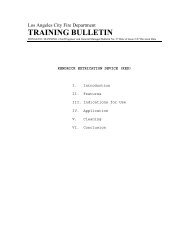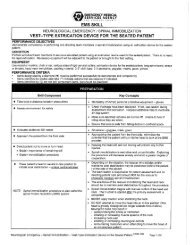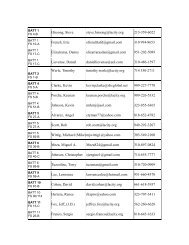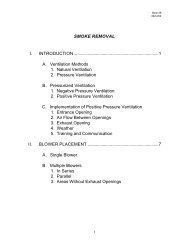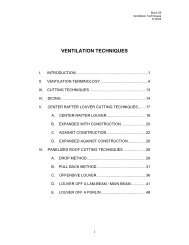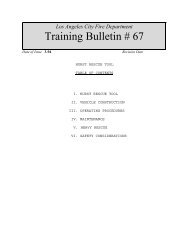TB # 53 Los Angeles City Fire Department Study Sheet AIR ...
TB # 53 Los Angeles City Fire Department Study Sheet AIR ...
TB # 53 Los Angeles City Fire Department Study Sheet AIR ...
You also want an ePaper? Increase the reach of your titles
YUMPU automatically turns print PDFs into web optimized ePapers that Google loves.
<strong>TB</strong> # <strong>53</strong><br />
<strong>Los</strong> <strong>Angeles</strong> <strong>City</strong> <strong>Fire</strong> <strong>Department</strong><br />
<strong>Study</strong> <strong>Sheet</strong><br />
<strong>AIR</strong> AMBULANCE<br />
Published Date<br />
8/29/88<br />
1. The purpose of the Air Ambulance is to transport a ________________ patient to a<br />
___________________ center or other specialized medical facility.<br />
2. The Incident Commander (including the 1 st on-scene _________ personnel) should<br />
not hesitate to request an Air Ambulance if operational circumstances warrant its<br />
use.<br />
3. Helicopter ______ is the primary Air Ambulance.<br />
NOTE: (5/11/1999 update #2 is primary and #1 is alternate, #3 needs to be<br />
reconfigured and they are waiting for #4)<br />
4. If Helicopter 1 is not available, then Helicopters _____ or _____ are used as Air<br />
Ambulance.<br />
5. The normal staffing complement dispatched on an Air Ambulance is _____ pilots,<br />
_____ paramedics and _____ Helitac crewmembers.<br />
6. The Air Ambulance can normally carry ______ ____ patients per trip.<br />
7. If needed, for high-density transportation of up to _____ _____ patients can be<br />
accomplished with ______ _____.<br />
8. The Air Ambulance can normally receive patients on either side. However the<br />
___________ side is preferred.<br />
9. The most hazardous parts of a helicopter are the turning ______ rotor and the<br />
_________ rotor.<br />
10. Wires or electrical lines in the ___________ or __________ path are one of the<br />
greatest hazards to any Air Ambulance operation.<br />
11. The suggested landing area size is ______ feet by ______feet or larger.<br />
12. The NORMAL landing pad is ________feet by ________feet.<br />
13. The approach and departure angle should not exceed _____ degrees if possible.<br />
14. Parking lots, parks, playgrounds and vacant lots, when free of people, ______ and<br />
vehicles often are suitable sites.<br />
1 <strong>TB</strong>0<strong>53</strong> SG<br />
05/09/99
<strong>TB</strong> # <strong>53</strong><br />
<strong>Los</strong> <strong>Angeles</strong> <strong>City</strong> <strong>Fire</strong> <strong>Department</strong><br />
<strong>Study</strong> <strong>Sheet</strong><br />
<strong>AIR</strong> AMBULANCE<br />
Published Date<br />
8/29/88<br />
15. Consider the risk of downwash or wind damage to large area ___________ in<br />
storefronts and residences. Maybe you don’t want to have the helicopter land there.<br />
16. The basic landing site criteria is ______________.<br />
17. The __________ will make the final determination reagarding landing and takeoff,<br />
based on existing conditions.<br />
18. Downwash from the Air Ambulance can produce a _____ MPH wind<br />
19. For nighttime, crossed headlight beams from apparatus pointed in the direction the<br />
Air Ambulance is expected to land (aimed into the wind towards the path of<br />
______________).<br />
20. All patients (with or without trauma) shall be placed on a ________ or _________.<br />
21. A ____-tag, with all patient information shall be placed securely on the patient. If<br />
there is time, the pink copy of the _____M shall be completed and given to the Air<br />
Ambulance Paramedic.<br />
22. Under normal conditions, the Air Ambulance should be on the ground for no more<br />
than ___ to___minutes.<br />
23. At night, flashlight and the like, should be held in ________ hands.<br />
24. ALL personnel near the landing site shall wear ____________, __________ (with<br />
tightened chinstrap!) and ___________ clothing.<br />
25. Approach and depart the Air Ambulance from the _________. If the landing site is<br />
sloped, do not approach or depart from the ___________ side.<br />
26. All personnel shall remain at least ______feet away from the Air Ambulance unless<br />
otherwise assigned.<br />
27. Avoid placing feet next to _______ as they may spring outward up to ______inches.<br />
28. The designated “__________” should assume a position in front of the Air<br />
Ambulance and check for ______ or other aircraft overhead.<br />
29. When the Pilot gives the “Thumbs-up” signal and the takeoff path is clear, the guide<br />
should give the Pilot the ______ signal and then MOVE out of the way.<br />
2 <strong>TB</strong>0<strong>53</strong> SG<br />
05/09/99



